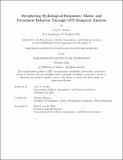Deciphering Hydrological Responses: Elastic and Poroelastic Behavior Through GPS Temporal Analysis
Author(s)
Sandoe, Lucy A.
DownloadThesis PDF (9.093Mb)
Advisor
Herring, Thomas
Terms of use
Metadata
Show full item recordAbstract
Hydrologic features, such as lakes and reservoirs, load the surface of the earth which causes measurable deformation. As the surface is loaded, there is a vertical and horizontal deflection, with reference points moving downwards and towards a load as the surface is depressed. The horizontal and vertical deformation from reservoir loading can be seen in Global Positioning System (GPS) data. In the first chapter of this thesis, we use 18 years of data from GPS sites across Northern California, and we invert for the loads associated with different hydrologic regions on a finer scale than previous studies. We take a novel approach to regularization: the inversion is performed using the vertical components of deformation, but we regularize using the misfits of the horizontal components of deformation which are semi-independent of the signal used in the inversion, thus avoiding overfitting noisy signals or over smoothing sharp features. We validate the inversion on Lake Shasta, a large, confined reservoir with known capacities, before performing a preliminary study of the Northern Sierras, Klamath Mountains, and Black Rock Desert. By robustly inverting remote sensing data for hydrologic mass, we provide insights on water storage budgets on a reservoir-scale across a critical and drought-prone region.
However, there are some regions which can exhibit a porous or poroelastic response to surface water loading. In these areas, the subsurface can expand with the introduction of water; either by the filling of pore spaces or inflation of subsurface reservoirs. This process has the opposite sign of elastic loading, can have temporal delays, and is often nonlinearly recoverable. In Chapter 2, in order to accurately understand and quantify the effects of water loading, we use the degree of correlation between the modeled hydrology at each site and the actual GPS station timeseries, then extrapolate spatially, finding areas of higher and lower correlation with elastic deformation across the Western United States. We also study the dates of peak seasonal amplitude throughout the region. These factors will determine which regions can be modeled with elastic loading, which need a more complex poroelastic model, and which may have some hydrologic delay. The classification will also inform the relative drought resiliency of different regions by highlighting areas where an influx of water may have a delayed impact on reservoir recovery.
Date issued
2024-02Department
Massachusetts Institute of Technology. Department of Earth, Atmospheric, and Planetary SciencesPublisher
Massachusetts Institute of Technology